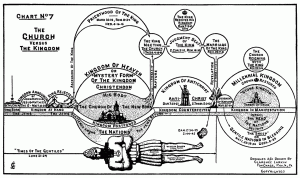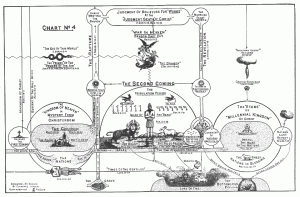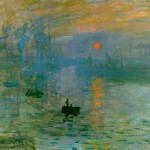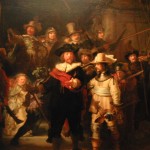I stood with my jaw dropped at an East Texas pastor’s home. Toward the end of dinner, the talk turned to theology. He questioned me on my eschatology–those end time views guaranteed to stir the hornets’ nest. I gave them reservedly, wondering if my host had a guillotine for those who weren’t in his ‘camp’ hidden somewhere in a closet. He seemed that type. I didn’t have to wonder long. His face scoured, and he stated that we should talk more theology after dinner, quickly changing the subject so as to not let my views spoil his dessert. Finally, the moment I knew was coming, came. It was time to get schooled. Post-dinner, instead of brandy–he was thorough going T-Totaler which was fine with me–he invited me into his study. As he flipped on the lights, both literally and figuratively in his intent, before me stood a three-fourths completed wall mural, an exact replica of Clarence Larkin’s circa 1920’s chart of the End Times. 
Its detail was exquisite, the desire for accuracy made obvious by the overhead projector location on the floor marked by blue masking tape so as to accurately beam this theological masterpiece onto the wall. As I gazed at his version of the Sistine Chapel, he simply looked over at me, pointed at the wall and said, “Brother, THAT is the truth.” My mouth was wide open, not because of the truth or detail of the chart, but because I was thinking, “Who would spend this type of energy on a replicating a chart?”
When we think of the end times, or eschatology, most people’s mind instantly go to timelines or charts. Of course, the most detailed charts are made by those who read the text “most literally.” But what if Revelation, Daniel and the apocalyptic genre were meant to be read ‘literaturely’ not literally? Fully inspired, YES! Literal, maybe not.
What if we were supposed to view the end time apocalyptic biblical passages more like a Monet than a Rembrandt?


What if it God gave us broad theological brush strokes and we were to stand back from it and take it in, not approaching every individual phrase looking for micro-correspondence to our own historical time-frame? What if God wanted us less consumed with locusts or geopolitical maps as much as the overarching beauty of the return of Christ? Maybe it is time to flip off the overhead projectors,or iPads you hiptsers, whether we be dispensationalists or amillenialists. Granted, an amillenial chart is quite boring, one arrow.
What if instead we remember that eschatology is much more about the fact that:
1. Christ will physically return delivering the hope of the resurrection.
2. Good will ultimately overcome evil, and evil will be judged.
3. History is not random and chaotic, but is being guided by God to its climax.
4. A new earth will be established where we can live out what was intended for us in Eden:
a. Perfect fellowship with God.
b. Perfect community with one another.
c. Perfectly stewarding His rule to the new creation (Three Purposes).
5. God will be worshiped and glorified for eternity, being shown to be a faithful, gracious promise keeper!
So maybe I–we–should all take a big step back from the text, put down our paints and instead look at the non-chronological aspects of Christ’s return allowing it to have a purifying effect on us–ME included!
Beloved, we are God’s children now, and what we will be has not yet appeared; but we know that when he appears we shall be like him, because we shall see him as he is. And everyone who thus hopes in him purifies himself as he is pure.
(1 John 3:2-3)
Amen. More to come…